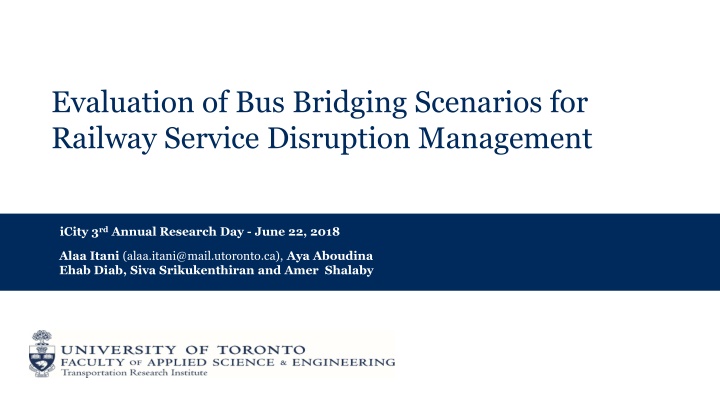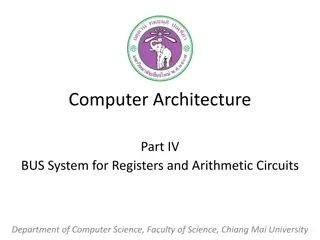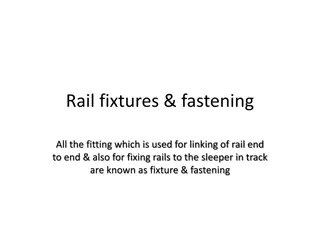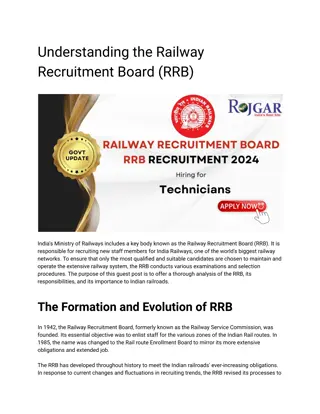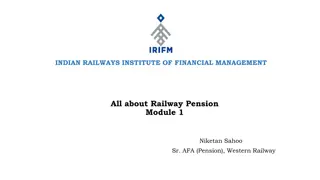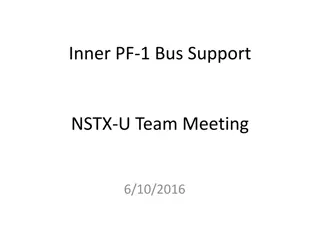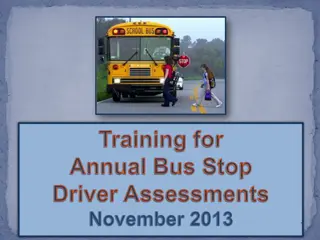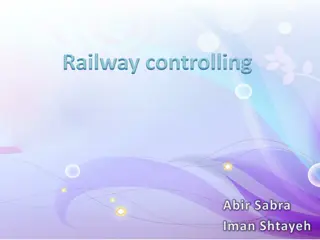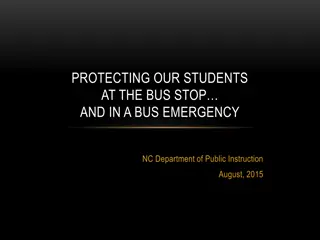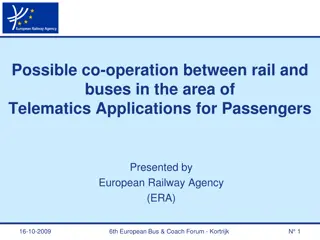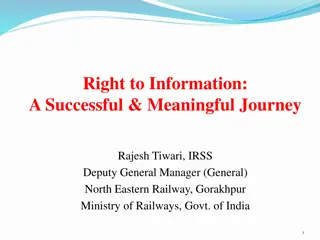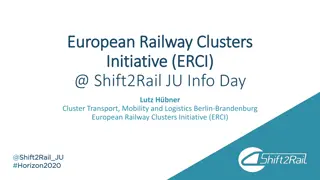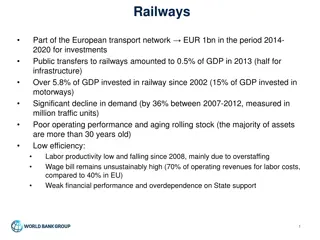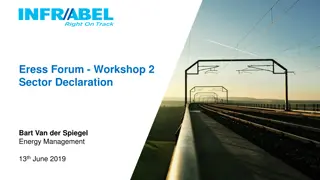Evaluation of Bus Bridging Scenarios for Railway Service Disruption Management
Public transit disruptions can greatly impact user experience, prompting transit agencies to implement various strategies such as bus bridging. This research evaluates different bus bridging scenarios for railway service disruptions, aiming to develop a decision support tool for transit agencies to select the most effective response plans. The study includes international practices, bus bridging strategies, recent research efforts, objectives, and a user delay modeling tool methodology.
Download Presentation

Please find below an Image/Link to download the presentation.
The content on the website is provided AS IS for your information and personal use only. It may not be sold, licensed, or shared on other websites without obtaining consent from the author.If you encounter any issues during the download, it is possible that the publisher has removed the file from their server.
You are allowed to download the files provided on this website for personal or commercial use, subject to the condition that they are used lawfully. All files are the property of their respective owners.
The content on the website is provided AS IS for your information and personal use only. It may not be sold, licensed, or shared on other websites without obtaining consent from the author.
E N D
Presentation Transcript
Evaluation of Bus Bridging Scenarios for Railway Service Disruption Management iCity 3rd Annual Research Day - June 22, 2018 Alaa Itani (alaa.itani@mail.utoronto.ca), Aya Aboudina Ehab Diab, Siva Srikukenthiran and Amer Shalaby
Introduction Public transit is an essential service for any city When unexpected interruptions occur, they reduce the quality of service provided to the public and affect negatively user experience Thus, transit agencies implement several disruption management strategies to mitigate the impact of unexpected disruptions and incidents on user delays
International Practices for Managing Unplanned Rail Disruptions Direct commuters to other network lines Single track operations Bus Bridging Toronto Transit Commission, TTC (Canada) Chicago Transit Authority (United States) Amtrak (United states) Washington Metropolitan Area Transit Authority (US) London Underground (United Kingdom) Soci t de Transport de Montreal (Canada) MetroTrains (Australia)
Bus Bridging Strategy Route C Route A Route D A B Route B Route E
Bus Bridging Research Efforts Recent Research Studies Quantifying the impact of bus depots location on travel time of shuttle buses The impacts of generating a temporary shuttle-buses network Economic analysis of keeping shuttle buses in reserve Few efforts focus on quantifying the impact of pulling shuttle buses from scheduled services on the overall system performance, including bus riders.
Objectives Develop a data-driven analytical tool for estimating: Shuttle bus performance User delays Assess different bus bridging response plans Provide transit agencies with a decision support tool for the selection of appropriate response plans
User Delay Modelling Tool Methodology 1) Shuttle Bus Trip Tracking Metro incident reported to control center Shuttle buses returned to regular service Deadhead time (II) Initial response time Buses Requested Incident cleared Bus pull out time Shuttle service time Buses retracted from route terminals Buses on Shuttle Service Deadhead time (I)
User Delay Modelling Tool Methodology 2) Metro Passengers Queue Evolution # of Passengers Total Subway Passenger s Delay = Area between Curves Arrival Curve at station A or B Train load Departure Curve Time Start of Disruption End of Disruption
User Delay Modelling Tool Inputs 1) Bus Bridging Scenario Specification Information Incident location (start and end stations of the disrupted railway segment). Incident Related Information Incident start time and expected duration. Number of shuttle buses to be dispatched (?). Shuttle Buses Related Information Selected bus routes from which shuttle buses will be dispatched. The number of buses to be dispatched from each route (??). The end station (A or B) to which each shuttle bus will be initially dispatched.
User Delay Modelling Tool Inputs 2) Transit Demand/Service Data and Travel Time Info Train loads and arrival frequency at both ends of the disrupted segment. Railway Segment Related Data The arrival rate of local transit users at each station/direction along the disrupted segment. The average number of alighting passengers at each station/direction along the disrupted segment. Transit Demand/Service Data Bus service frequency. Bus Routes Related Data Bus average ridership (i.e., total number of boarding passengers) per cycle. Bus average cycle time. Travel time of each shuttle bus between the closest route terminal to the disrupted railway segment and one end of the segment (i.e., bus deadhead times). Bus travel times between adjacent stations along the disrupted railway segment. Travel Time Data (Traffic Network)
User Delay Modelling Tool Outputs Estimates for each Disrupted Station Estimates for each Shuttle Bus Metro passenger delays Shuttle bus fleet arrival times and associated occupancy levels throughout the disruption period Queue length at the end of disruption The maximum passenger queuing delay The maximum queue length Estimated Aggregate Values Total metro passenger delays Rider delays Total bus rider delays Out-of-original-service time Total user delays (both) Shuttle in-service time Total bus waste time (of non-utilized buses) Bus utilization check The delay associated with queue dissipation following end of event The percentage of utilized shuttle buses
TTC Case study: Evaluating Bus Bridging Response Plans DAILY BUSES ALLOCATION Y.U.S / B.D 30 MIN + 30 MIN + 30 MIN + 1 - 30 MIN 1 - 30 MIN 1 - 30 MIN TIME FRAME Total buses 1 - 4 5 - 9 10 + 1 - 4 10 + 5 - 9 STATIONS STATIONS STATIONS STATIONS STATIONS STATIONS A.M 6 - 9 AM 1325 44 88 133 22 44 66 9 AM 3 PM MID 881 29 59 88 15 29 44 PM 3 7 PM 1426 47 95 143 24 47 71 E.E. 7- 10 PM 819 27 55 82 14 27 41 LE. 10PM - 1AM 506 17 34 51 8 17 25
Selecting an Actual Disruption Disruption occurred at St. Clair station between 5:54 and 6:25 am on a weekday. The disrupted segment is part of Yonge-University Line (Line1), and it extends between Bloor-Yonge (BY) and Eglinton station Inclusively, 6 stations are closed The Incident duration was 31 min 23 buses were dispatched
Running the Tool Using the Selected Incident 1,729 Eglinton 18 94 Davisville 77 57 St. Clair 5.7 bus-hr wasted time NorthBound Platforms South Bound Platforms 22.5 7 Summerhill 8 5 20 Rosdale 15 734 Bloor-Yonge Couldn't Serve Served Delays at the Disrupted Subway Stations (Passenger-hr)
Observed Vs. Estimated Measurements 25 Observed Estimated 20 15 Bus-hr 10 5 0 Total buses out-of-original- service time Total bus dead-head time Total wasted time of buses 100% Observed Estimated 80% 60% 40% 20% 0% Percentage of Utilized Buses
Tested Bus Bridging Strategies ModifiedSpecifications Bus Bridging Scenarios Scenario 0: Baseline Scenario No modification Incident duration reduced from 31mins to 25mins Scenario 1: Shorter Incident All shuttle buses are dispatched to Bloor-Yonge station first Scenario 2: BY ALL All shuttle buses are dispatched to Eglinton station first Scenario 3: Eglinton ALL Number of shuttle buses reduced from 23 to 15 Scenario 4: Fewer Buses Shuttle buses are dispatched from nearby routes. Scenario 5: Different Routes
Assessing Alternative Strategies: Smaller-Size Shuttle Fleet and Nearby Routes Non-utilized shuttle buses Reduction in: 100% 100% Subway users delay Bus riders delay 51% 49% 35% Deadhead time 18% 6% Wasted time 0%
Whats Next? Compare different bus bridging response plans Determine the major factors that affect user delay Sensitivity Validate the tool using more incidents Use more recent data, once available Robust Validation Develop an optimization model which utilizes the user delay modelling tool to determine the optimal bus bridging response plan under a given set of conditions Optimization Framework
